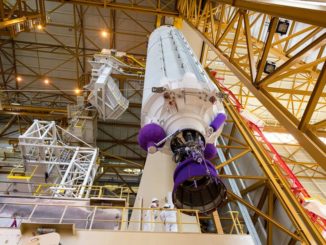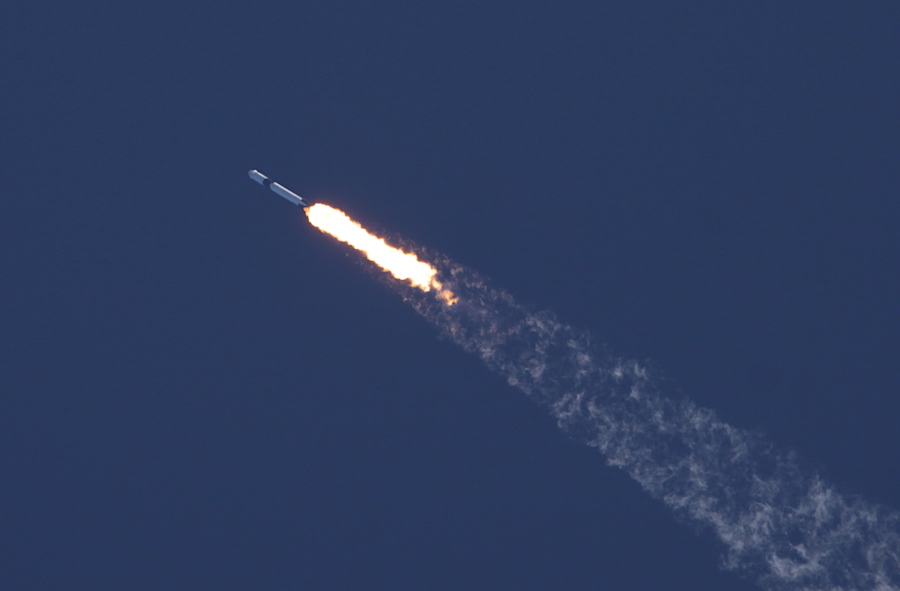
A commercial Dragon supply freighter built and owned by SpaceX rocketed into a clear blue sky over Florida’s Space Coast Thursday with a menagerie of research experiments and holiday surprises heading for the International Space Station.
Scientists loaded 40 genetically-engineered into the Dragon capsule to help gauge the effectiveness of an experimental drug to combat muscle and bone atrophy. There’s also an experiment sponsored by Anheuser-Busch to study the malting of barley in microgravity, which could lead to the brewing of beer in space, the company says.
A combustion experiment to be delivered to the station will guide research into the behavior of flames in confined spaces in microgravity. NASA and commercial teams have disclosed seven CubeSats stowed inside the Dragon spacecraft for deployment in orbit, including the first nanosatellite built in Mexico to fly to the space station.
And there are a few holiday treats in store for the space station’s six-person crew.
“As far as presents and so forth, I’m not sure I want to divulge anything, but I think I would tell you that Santa’s sleigh is certified for the vacuum of space,” joked Kenny Todd, manager of space station operations and integration at NASA’s Johnson Space Center in Houston.
Crammed full of 5,769 pounds (2,617 kilograms) of equipment, the automated cargo freighter blasted off from pad 40 at Cape Canaveral Air Force Station at 12:29:24 p.m. EST (1729:24 GMT) Thursday to kick off a three-day trek to the space station.
The 213-foot-tall (65-meter) Falcon 9 launcher ignited nine Merlin 1D main engines to climb away from pad 40 with 1.7 million pounds of window-rattling thrust. A clear autumn afternoon sky greeted the kerosene-fueled Falcon 9 as it turned northeast from Cape Canaveral to align its flight path with the space station’s orbit.
The takeoff occurred a day behind schedule after extreme high-altitude winds prevented the Falcon 9 from launching Wednesday. But the upper level winds subsided enough Thursday to permit the Falcon 9’s fiery departure, and the commercial launcher successfully delivered its Dragon cargo payload into a preliminary orbit eight-and-a-half minutes later.
The Falcon 9’s first stage did the first bit of lifting before detaching two-and-a-half minutes into the flight. The first stage booster flew itself back through Earth’s atmosphere and landed on SpaceX’s drone ship “Of Course I Still Love” parked in the Atlantic Ocean east-northeast of Jacksonville, Florida, marking the 46th time SpaceX has recovered one of its boosters intact for reuse on a future flight.
The first stage flown on Thursday mission made its first trip to space and back.
Meanwhile, the Falcon 9’s second stage lit its single Merlin engine to inject the Dragon supply ship into orbit. A minute later, the cargo capsule deployed from the second stage of the Falcon 9, and a forward-mounted camera showed the Dragon flying away from the rocket against the inky blackness of space.
SpaceX confirmed the supply ship extended its power-generating solar panels to a span of 54 feet (16.5 meters), and all of the ship’s Draco maneuvering thrusters were primed to begin a series of maneuvers to rendezvous with the space station early Sunday.
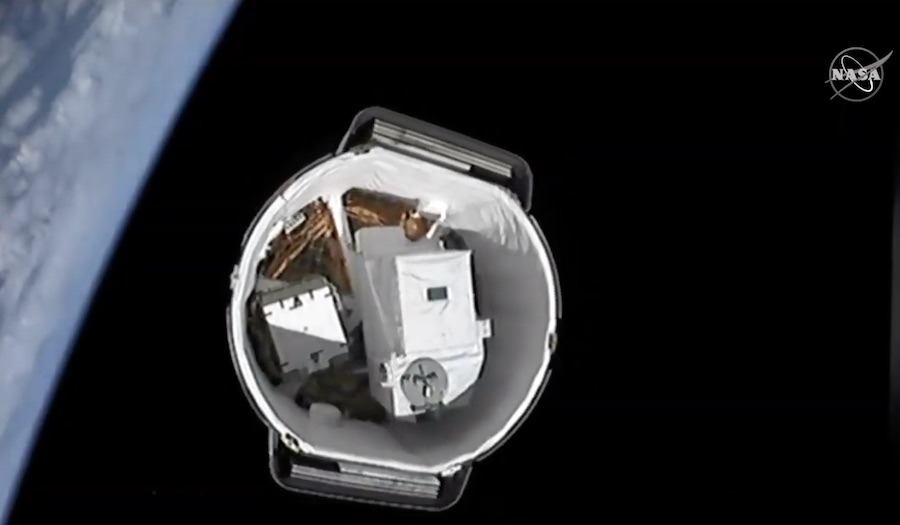
After releasing the Dragon spacecraft, the Falcon 9 rocket’s upper stage was expected to continue on an extended-duration coast lasting nearly six hours. SpaceX intended to collect thermal data and other information on the performance of the stage during several orbits of the Earth, before the Merlin engine reignites for a long disposal burn to drive the rocket body back into Earth’s atmosphere for a destructive re-entry over the far southern Indian Ocean.
SpaceX said the long-duration experiment is necessary to verify the upper stage’s readiness to support future missions that might require the rocket to coast in the extreme environment of space for up to six hours. Missions that require that capability include high-altitude orbital injections for U.S. military and National Reconnaissance Office satellites.
The extended flight of the upper stage was expected to take up some of the Falcon 9’s excess fuel capacity, leaving insufficient propellant in the first stage to allow the booster to return to a landing at Cape Canaveral. Instead, SpaceX landed the rocket at sea.
The launch of SpaceX’s Falcon 9 rocket clears the way for two other major spaceflight activities on opposite sides of the world.
At Cape Canaveral, United Launch Alliance is readying an Atlas 5 rocket for an 11-hour mock countdown Friday to rehearse procedures for the first launch of Boeing’s Starliner crew capsule later this month. The countdown exercise will include filling of the Atlas 5 with liquid propellants at Cape Canaveral’s Complex 41 launch pad, a little more than a mile away from SpaceX’s Falcon 9 launch facility at pad 40.
The Atlas 5’s practice countdown at pad 41 could not go ahead the same day as SpaceX’s launch from the neighboring pad.
Russian teams in Kazakhstan plan to launch a Soyuz booster at 4:34 a.m. EST (0934 GMT) Friday with a Progress resupply and refueling freighter. The Progress cargo mission is scheduled to dock with the space station early Monday, roughly 24 hours after the arrival of SpaceX’s Dragon spacecraft.
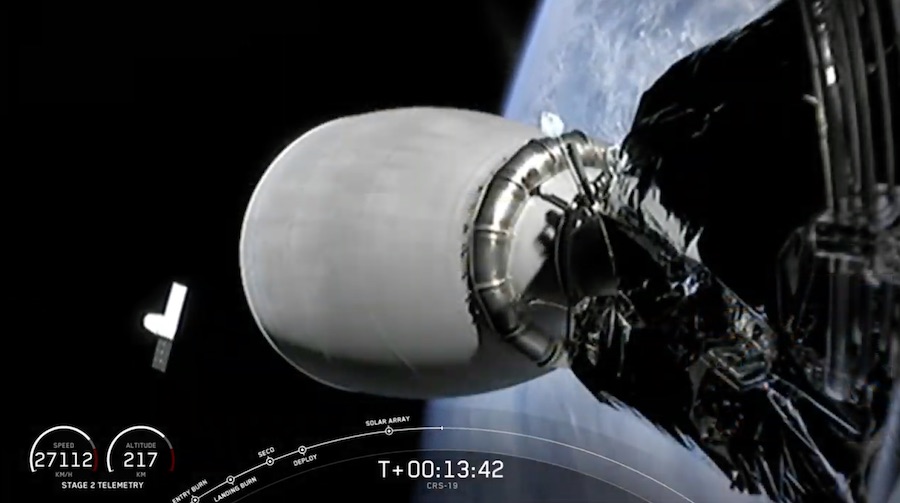
Italian astronaut Luca Parmitano and NASA flight engineer Drew Morgan will man the space station’s Canadian-built robot arm to capture the Dragon supply ship Sunday. The robotic arm will position the Dragon spacecraft on the station’s Harmony module, where astronauts will open hatches and begin unpacking the cargo inside the supply ship’s internal compartment.
The Dragon cargo capsule launched Thursday is making its third voyage to the space station, following two previous round-trip flights in 2014 and 2017. This mission is SpaceX’s 19th resupply flight to the station under a multibillion-dollar contract with NASA.
Here is a break-down of the Dragon spacecraft’s 5,769-pound (2,617-kilogram) supply load. The figures below do not include the mass of cargo packaging, which is included in NASA’s overall payload mass:
- Science Investigations: 2,154 pounds (977 kilograms)
- Vehicle Hardware: 675 pounds (306 kilograms)
- Crew Supplies: 564 pounds (256 kilograms)
- Spacewalk Equipment: 141 pounds (65 kilograms)
- Computer Resources: 33 pounds (15 kilograms)
- Unpressurized Payloads: 2,037 pounds (924 kilograms)
Eight of the 40 mice launched toward the space station Thursday have been genetically-engineered to lack myostatin, a protein that acts to limit muscle growth in animals. The muscle-bound, myostatin-free mice — or “mighty mice” — are joined by four other groups of rodents, including groups that will be given an experimental drug in space to block myostatin activity and promote muscle growth.
All 40 mice will return to Earth alive on the Dragon capsule in early January. Scientists will administer the same myostatin protein blocker to some of the mice after they are back on the ground to assess how the drug affects their rate of recovery.
“The focus of this project is going to be to determine whether getting rid of myostatin in mice that we send to the International Space Station can prevent, or at least mitigate, the loss of muscle due to microgravity,” said Se-Jin Lee, professor at the Jackson Laboratory and University of Connecticut School of Medicine, and principal investigator for the rodent research experiment.
The drug trial to be administered to the mice on the space station also inhibits activin, a protein that regulates bone mass.
“By blocking activin with this drug, bone density increases significantly,” said Emily Germain-Lee, a co-investigator on the experiment and professor at University of Connecticut School of Medicine. “And as you probably know, astronauts who spend a lot of time in space lose not only muscle mass, but also bone mass.
“Anything that can be done to prevent muscle and bone loss would be very important to maintaining the health of astronauts during space travel,” Germain-Lee said. “But … loss of bone mass is also a huge health problem for people here on Earth. There are actually lots of diseases that lead to bone loss in both children and adults. And, of course, osteoporosis is a big health issue for people who are elderly or bedridden.
“By testing this experimental drug in life subjected to microgravity, we hope to be able to test the therapeutic strategies for combating both the bone loss and muscle loss that occur in lots of different conditions,” Germain-Lee said.
Gary Hanning, director of global barley research at Anheuser-Busch, said the company’s malting experiment aboard the Dragon cargo mission is the third in a series of investigations looking at how the environment of space affects brewing processes.
“This series has been constructed to look at the impact of space environment on the germination process of barley,” Hanning said. “So the germination processes is taking seed and creating the new plant from that, and so that’s a very key step in the life cycle of any plant, and particularly important to malting barley. So much of our research on earth is focused on seed germination and the environmental impacts that would affect seed germination, as well as physiological effects.”
Hanning said Anheuser-Busch’s experiments in space have given the company’s research team a new perspective.
“From our previous studies on the space station, we’ve noted that the gene expression — that’s the genes that are turned on or turned off and to what degree — are different on the space station then they are on Earth,” he said. “We think it’s a response to the stress, because it’s an abnormal environment, so there’s a stress related there. So gene expression is a part of that cascade of events as part of germination.”
The experiment launching on SpaceX’s next cargo mission will look at hardware solutions to support barley malting on the space station.
“Malting is basically a biological process,” Hanning said. “It is to convert barley into a product called malt, which is used in a lot of food and beverage applications. Malting is actually a three-step process,” he added, beginning with the steeping, or hydration, of barley grains, followed by germination and drying.
The Anheuser-Busch experiment launched with just 2.5 ounces (70 grams) of barley grains, separated into two units.
Another research payload aboard the Dragon spacecraft will allow scientists to observe flame behavior in confined spaces in microgravity. The combustion package includes solid fuel samples that will be ignited inside a protective enclosure on the space station.
“We want to study how solid materials burn in different confined conditions, and how fire interacts with its immediate surroundings,” said Ya-Ting Liao, a professor of mechanical and aerospace engineering at Case Western Reserve University.
“It turns out this is a very hands-on experiment,” said Paul Ferkul, an investigator on the confined combustion experiment. “We’re talking with the astronaut, we’re interacting with him, we’re telling him what to do, how to set the parameters. And he, in turn, tells us how it’s looking, what he’s experiencing, and the astronauts are very glad to do this.
“It’s way outside their usual routine on the space station, so that helps us a lot because they’re enthusiastic for our work, and they make very good investigators because of that.”
The Dragon capsule’s external cargo bay is loaded with a Japanese Earth-imaging instrument with high spectral sensitivity. The Hyperspectral Imager Suite, or HISUI, instrument will image Earth’s surface in 185 spectral bands, allowing scientists to distinguish between the composition and type of a range of vegetation, soil, rocks, snow, ice, and human-made objects like buildings, roads and other structures.
Using the robotic arm, the HISUI instrument will be mounted to a fixture outside the station’s Japanese Kibo lab module. It’s a follow-up to the Japanese-developed ASTER instrument on NASA’s Terra satellite, which launched in 1999.
A new lithium-ion battery for the space station’s solar array truss is also stowed inside the Dragon capsule’s unpressurized trunk. It will replace a battery flown to the station by a Japanese HTV cargo ship last year.
That battery was damaged by an electrical short soon after it was installed on a spacewalk.
Other equipment slated for delivery to the space station include a robotic tool stowage platform to store leak detectors outside the space station, and upgrades to allow scientists to make subtle measurements of gravity using the Cold Atom Laboratory, a research facility inside the orbiting lab.
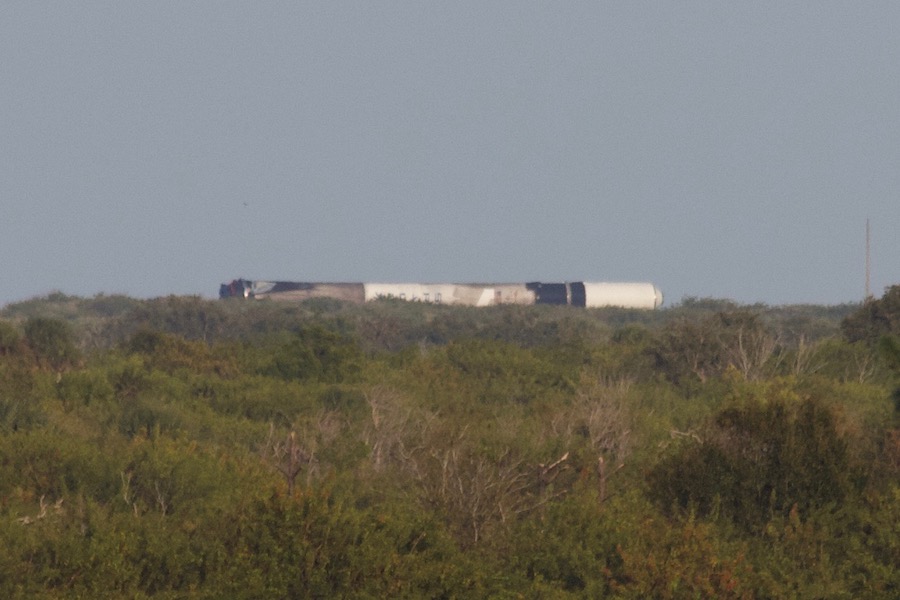
With the Dragon cargo launch out of the way, SpaceX is gearing up for its next Falcon 9 flight in mid-December from pad 40 at Cape Canaveral.
A Falcon 9 rocket — without its payload — was seen rolling from SpaceX’s hangar at pad 39A to nearby pad 40 Thursday afternoon, several hours after the previous Falcon 9 mission took off. The Falcon 9 appeared to feature a previously-flown first stage booster, with a new second stage attached to it.
The rocket moved Thursday afternoon to pad 40 is likely assigned to launch the JCSAT 18/Kacific 1 communications satellite, a Boeing-built craft designed to relay broadband signals across the Asia-Pacific region.
The launch of the JCSAT 18/Kacific 1 communications satellite was scheduled for no earlier than Dec. 15 after an unusually rapid turnaround following the CRS-19 cargo launch to the space station. It was not immediately clear whether the one-day slip in the CRS-19 launch this week might similarly delay the JCSAT 18/Kacific 1 launch.
Email the author.
Follow Stephen Clark on Twitter: @StephenClark1.


